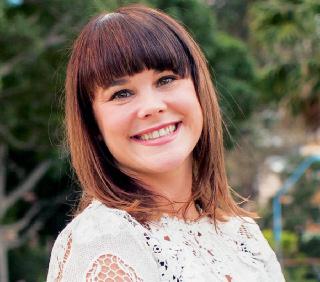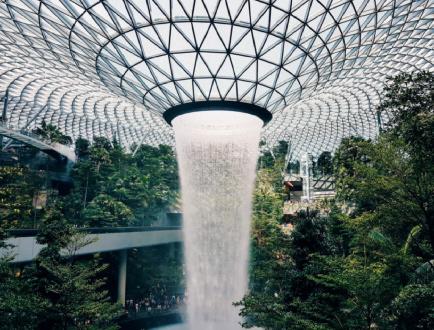
5 minute read
REVIEWING URBAN DESIGN

REVIEWING URBAN DESIGN Outdoor Design Source interviews landscape architect Angela Koepp, Principal at urban planning and design fi rm RobertsDay
With over 17 years’ experience in urban design, Angela Koepp was recently invited by Government Architect NSW to join the NSW State Design Review Panel (SDRP). Selected for her highly regarded knowledge of and experience in urban design and placemaking, Angela will advise on and provide technical and design insight into all State Signifi cant projects submitted to SDRP for design review; specifi cally, as an independent panel member for the Parramatta Light Rail Stage 1 design excellence panel.
With such insight into our built environment, Outdoor Design Source couldn’t resist asking Angela for her views on the state of urban design in Australia today.
Q. I would imagine it is a career highlight for anyone, getting the chance to have a say in shaping our built environment. What does your nomination to SDRP mean to you personally and professionally? A. I’ve always held the NSW Government Architect Offi ce in the highest regard. Being invited to join their “design excellence” team is an honour. With my expertise in place-led masterplanning, I look forward to helping shape greener, more people-friendly places. Personally, being part of group contributing to the healthy evolution of our communities and a safer, happier, more enriching future for our families is very close to my heart.
Q. The State Design Review Panel is a fairly new programme. What do you see as its key objectives, and how much of an impact do you believe it is having on urban planning in Australia? A. The SDRP aims to provide multidisciplinary technical and design insight into and advice on all State Signifi cant projects that undertake design review by the SDRP. A core objective is to provide a statewide coordinated and consistent design review process.
This process is endeavouring to lift the quality of design across these projects by bringing independent thought-leaders, government and agency representatives together to inspire and facilitate best practice, place-led development outcomes.
The SDRP is elevating development discussions beyond models of basic compliance and business as usual; reinforcing our responsibility to deliver great, lovable places designed for people.
106 | ODS Exemplary Showcase Q. What do you believe is the biggest driver influencing the development of public infrastructure and greenspace projects in our urban centres today? A. A mainstream behavioural shift towards the stewardship of our planet, whereby an increasingly sophisticated community demands infrastructure to support a reduced reliance on private vehicles, and green systems that support environmental and social resilience.
Q. In your opinion, what do our urban centres and public spaces need to be “wellbeing habitats” for humans? Where do you feel the focus should be? A. At RobertsDay, we believe in seven essential elements: identity, equity, greenery, urbanity, mobility, wellness and resilience. I am passionate about the benefi ts of meaningful attachment to places established through a genuine understanding of country, culture, community values and unique challenges.
Q. What do you see as being the major impediments to the eff ective creation of great people-centric urban environments, how do you see us overcoming them? A. Place-led communities instil common values
that have stood the test of time, inclu ding health, stimulation, human interaction and identity. Embedding these values into our approach to planning, designing and activating communities will future-proof places for the next generation. Leadership and accountability in all aspects of the development of urban environments are required. We have a collective responsibility to promote design excellence and integrated nextpractice place solutions.
Q. With over 17 years of experience in urban design, I imagine you’ve seen a wealth of change in attitudes toward our built environment, its role in and impact on daily life, and design trends in general. How would you describe its trajectory over the past two decades and the most obvious changes the sector has undergone? A. The emerging understanding that urban intensifi cation must be matched by public benefi t investment and commitment that is tailored to the place. The way in which we choose to balance living and working is changing our approach to place and urban design.
Following on from the enlightened moment where we decided we wanted a live-work balance that required mixed-use, dense

communities through to the emerging demand for live-work integration.
Live-work integration required place-led design with blurred boundaries, creative clustering and principles for collision economics to promote innovation, socialisation. Places, spaces and the built environment must be curated as well as self-determining.
Q. Which upcoming government or commercial development projects are you most excited about and why? A. My fi rm is currently engaged to provide the renewal of the Fairfi eld Town Centres, which presents an opportunity to deeply embed placebased thinking into the future redevelopment of the precincts’ public domain.
Our place-based approach, which is grounded in research and explores the social, cultural, economic and environmental attributes of a place in order to inform an understanding of the existing and future character, will deliver a Public Domain Plan for the Fairfi eld Town Centres.
Planning for the future of the Fairfi eld Town Centres will require an understanding of the past and present, and a consideration of the identity to support both short and long-term design and planning processes.
NSW STATE DESIGN REVIEW PANEL (SDRP) SDRP is a multidisciplinary panel of independent built environment experts comprised of landscape architects, urban planners and architects, who are responsible for delivering the principles and ambitions of Better Placed, and providing a consistent statewide approach to reviewing the design quality of major development proposals.
Since its inception in April 2018, SDRP has reviewed 57 projects worth $4.8 billion. Close to half of the projects were schools, with the remainder including student and aff ordable housing, hospitals, universities, public institutions, new precincts, sport facilities and private mixed-use developments.










